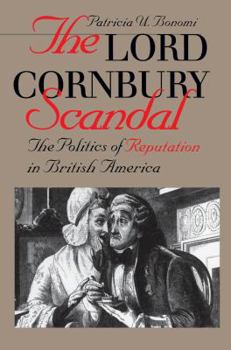Lord Cornbury Scandal the Politics of Reputation in British America
Select Format
Select Condition 
Book Overview
For more than two centuries, Edward Hyde, Viscount Cornbury--royal governor of New York and New Jersey from 1702 to 1708--has been a despised figure, whose alleged transgressions ranged from raiding the public treasury to scandalizing his subjects by parading through the streets of New York City dressed as a woman.
Now, Patricia Bonomi offers a challenging reassessment of Cornbury. She explores his life and experiences to illuminate such topics...
Format:Paperback
Language:English
ISBN:0807848697
ISBN13:9780807848692
Release Date:February 2000
Publisher:Omohundro Institute and Unc Press
Length:304 Pages
Weight:1.10 lbs.
Dimensions:0.8" x 6.0" x 8.9"
Customer Reviews
3 ratings
Admirably lucid
Published by Thriftbooks.com User , 18 years ago
The writer does indeed show how easily stories get garbled and tales get passed on as history. A great deal of scepticism or, at least, critical awareness is needed when looking at the past. This is a very readable and lucid book.
Maybe, Maybe Not
Published by Thriftbooks.com User , 22 years ago
The author argues convincingly that stories of Lord Cornbury's cross-dressing were only rumors. She offers some explanations as to why such rumors might have started but fails to consider one plausible explanation-- they were true. As evidence that the charges were untrue, the author cites the four letters which described Cornbury's behavior. Each was written by someone who disliked the colonial governor. Cornbury probably did not attend public functions in women's clothes. Rumors do tend to be embellished with each re-telling. The fact that someone has enemies, however, does not mean he can not also be a transvestite, consider J. Edgar Hoover. The fact that his enemies would be more likely to comment than his friends seems hardly surprising.
Some Flaws, but Still a Good Work
Published by Thriftbooks.com User , 24 years ago
The support community for heterosexual male transvestites in Vancouver, British Columbia, calls itself The Cornbury Society. The organization, like New York's famous Hyde Park, has taken upon itself the name of the third Earl of Clarendon, Edward Hyde, the Lord Cornbury, royal governor of New Jersey and New York from 1702 to 1708. These men, like most historians from the mid-19th century forward, believe that Governor Hyde was an exhibitionistic cross-dresser, who attended his own wife's funeral dressed in women's clothing, and cavorted about in society dressed as a woman, to the horror and condemnation of hundreds of spectators. This has been the historical legacy of Hyde for over 150 years, and it is Patricia Bonomi's task to not only refute these (and other) rumors, but illuminate the condition of politics and political discourse in the 18th century, and expose a long-standing bias in American history against royalists in general, and Tory governors in particular. She does this all in an engaging and descriptive manner, though with perhaps an insufficient degree of explanation of basic terminology and concepts (for example, she does not explain what she means by "Grub Street Press," a fundamental concept used from the first chapter forward, until page 102), and a organizational structure that seems to lack both organization and structure. There are three areas from which criticism of Governor Hyde has always stemmed. The most infamous is a portrait said to be of him, dressed in women's attire, now hanging in the halls of the New-York Historical Society, a portrait with which there is no connection to the Governor until many decades after his death. The second, and in many ways weakest, is a series of 5 letters containing rumor-mongering of the Governor's supposed cross-dressing habits. The final, and most serious, is a large group of more or less contemporary charges (primarily propagated by Lewis Morris, the man who was in line to become the royal governor of New Jersey until Hyde's father and uncle interceded) of fiscal misconduct, including accepting of bribes, mismanagement of colonial finances, and living far in excess of his position and means. Bonomi places each of these pieces of evidence into their proper political and social contexts, completely discrediting the portrait's connection to Hyde, and clarifying the difference between the rumors of the day and what actually took place. More importantly, Bonomi explains, to a certain degree, why these rumors were so prevalent, and why so many of the rumors focused on sexual innuendo. One does not need to look farther than the Monica Lewinsky scandal to see the application of Bonomi's findings to our understanding of our own time. A new form of media, greater press freedoms, and a large upheaval in the nature of political institutions and leadership are just three of many parallels between the late 17th/early 18th centuries, and the late 20





